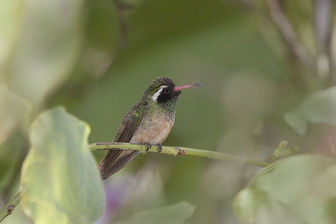Xantus's Hummingbird
Adults are colored predominantly green on their upperparts and back. The tail is darkly colored and straight. The most prominent feature is the white eyestripe found in both males and females. The stripe is further enhanced by a black eyestripe below the white one. Both have cinnamon brown underparts, with the brown extending further up the throat in the female. Green replaces the brown in the throat of the male. The bill of the male is straight and very slender. It is red in coloration, and shows a black tip. His crown and face is bluish-black.

Original source: marlin harmsPermission(Reusing this file)This image, which was originally posted to Flickr.com, was uploaded to Commons using Flickr upload bot on 13:21, 17 April 2011 (UTC) by DreamOfShadows (talk). On that date it was licensed under the license below.This file is licensed under the Creative Commons Attribution 2.0 Generic license.You are free:to share – to copy, distribute and transmit the work
Author: marlin harmsPermission(Reusing this file)This image, which was originally posted to Flickr.com, was uploaded to Commons using Flickr upload bot on 13:21, 17 April 2011 (UTC) by DreamOfShadows (talk). On that date it was licensed under the license below.This file is licensed under the Creative Commons Attribution 2.0 Generic license.You are free:to share – to copy, distribute and transmit the work
The Xantus's Hummingbird is classified as Least Concern. Does not qualify for a more at risk category. Widespread and abundant taxa are included in this category.
Xantus's Hummingbird, Basilinna xantusii, is a medium-sized hummingbird. It is 8-9 cm long, and weighs approximately 3-4 g. Adults are colored predominantly green on their upperparts and back. The tail is darkly colored and straight. The most prominent feature is the white eyestripe found in both males and females. The stripe is further enhanced by a black eyestripe below the white one. Both have cinnamon brown underparts, with the brown extending further up the throat in the female. More
The Xantus's hummingbird takes its name from the Hungarian naturalist who was the first to collect one in 1859. John Xantus de Vesey received the honor of a species named after him when another naturalist, George Lawrence, designated the species as the Xantus's hummingbird. The bird is what ornithologists term a vagrant visitor to parts of the Pacific Coast, meaning an occasional individual will fly much further north of the typical geographic range of the species. More
The Xantus's Hummingbird has a limited range reaching up to generally 42,000 square kilometers. This bird can be found in Mexico and the United States, and with a vagrant population in Canada. This species appears in forests and shrublands as well as arable regions, and can be found in both tropicl and subtropical environments.The global population of this species has not been quantified, but it is referred to as “frequent” in portions of its range. More
Xantus's HummingbirdHylocharis xantusii Order APODIFORMES – Family TROCHILIDAE Issue No. 554 Authors: Howell, Christine A., and Steve N. Howell * Articles * Multimedia * References Courtesy Preview This Introductory article that you are viewing is a courtesy preview of the full life history account of this species. The remaining articles (Distribution, Habitat, Behavior, etc. More
Xantus's Hummingbird: Rare to accidental in southern half of the peninsula of Baja California. Normally found in Mexico (Purissima south to San Jose del Cabo). Preferred habitats include arid to semiarid scrub, open brushy forests, and gardens. Breeding and Nesting Xantus's Hummingbird: Two dull white eggs are laid in a nest made of seeds, plant down, and dried flower heads, covered with lichens, and built from 4 to 12 feet above ground in a tree. More
the Xantus's Hummingbird (Hylocharis xantusii) is named after its eccentric collector, John Xantus. It is the only hummingbird endemic to Baja California. KEY CHARACTERISTICS Distinguished by a bold white eye-stripe and blackish cheek with cinnamon and rust tones in all plumages. DISTRIBUTION Resident from the southern end of Baja California along the eastern slope to mid-peninsula. Vagrants have wandered north of Mexico very rarely. More
Xantus's hummingbird, Hylocharis xantusii Violet-crowned hummingbird, Amazilia violiceps Blue-throated hummingbird, Lampornis clemenciae Ruby-throated hummingbird, Archilochus colubris Anna's hummingbird, Calypte anna The following are species of concern and have been negatively impacted by the introduction of weeds and destruction of California’s habitat, primarily the coastal sage scrub plant community. More
Should I report a Xantus's hummingbird seen in Northern California? = I saw this beautiful bird outside my window about a month ago. I didn't have any binoculars, so I watched it through a child's telescope, lol. I finally got around to looking it up in a bird identification program, and it turns out that it is not normally seen this far north (global warming, I guess). More
Family : Trochilidae
Genus : Hylocharis
Species : xantusii
Authority : (Lawrence, 1860)
